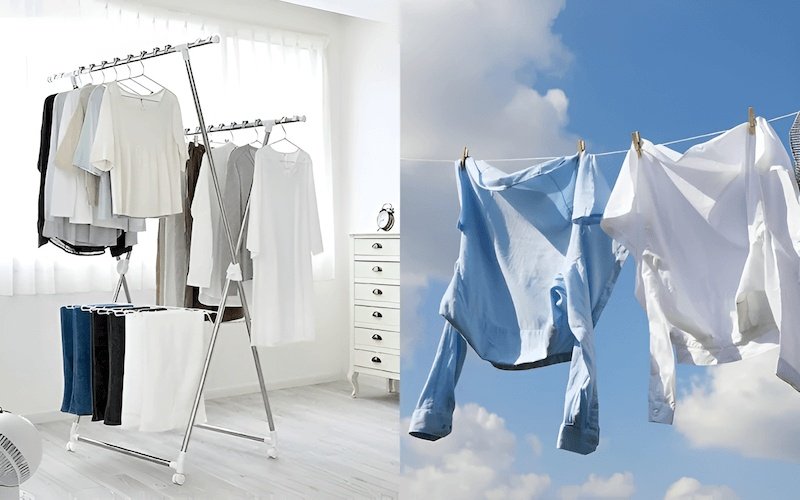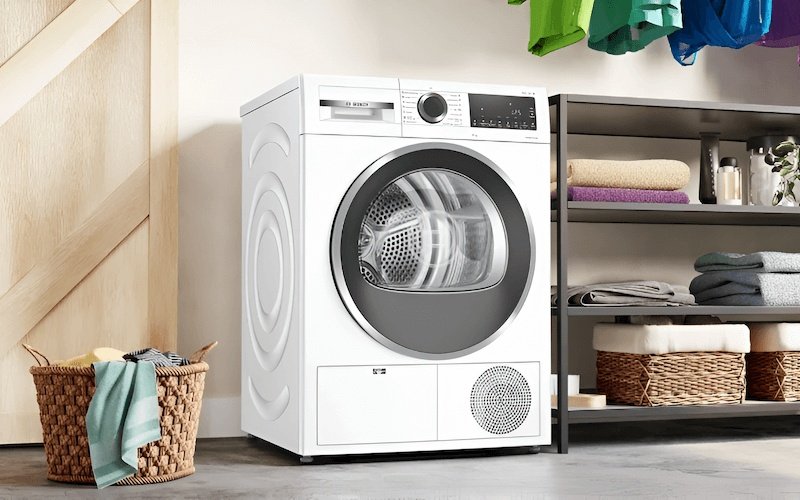Air Drying vs Machine Drying: Pros, Cons and Impact
Imagine a typical laundry day, where you are facing a gigantic pile of clothes. You’re probably wondering about the quickest route to get everything clean and dry. This article is here to help clarify your drying dilemma, offering a detailed comparison of air drying (hanging clothes to dry naturally) and machine drying (using a tumble dryer).
We’ll explore both methods, weighing their pros and cons to assist deciding on the best approach for various situations. The major factors we’ll be examining are cost savings, fabric care, and the overall environmental impact of each drying method. Ultimately, You’ll gain insight into making informed laundry choices that suit specific needs and preferences, also help preserve clothing and minimize your environmental footprint.
1. Understanding the basics: air drying and machine drying
1.1 Air drying
Air drying is a time-honored, natural method of drying clothes that relies on evaporation to remove moisture. This process involves exposing wet clothes to the air, allowing the surrounding environment to gradually wick away water. Various methods can be employed, including:
- Clothesline: An outdoor setup where clothes are hung on a line, typically made of rope or wire, exposed to sunlight and breeze.
- Drying Rack: A freestanding structure, often foldable, used for hanging clothes. Drying racks can be used both indoors and outdoors.
- Airflow and sunlight play a crucial role in removing damp.
Indoor vs. outdoor air drying
Both offer distinct advantages. Outdoor drying harnesses the power of sunlight, acting as a natural disinfectant and whitener, while also benefiting from increased airflow. However, outdoor drying is dependent on weather conditions and might expose clothes to pollen or pollutants.
Indoor drying provides a controlled environment, protected from the elements, but often requires adequate ventilation to prevent humidity buildup. Space is the other main consideration. Racks do require more space, and that may determine where it’s most practical to set up.

1.2 Machine drying
Machine drying employs heated air and a tumbling motion to rapidly remove damp from clothing. Clothes are placed in a rotating drum, where hot air circulates, accelerating the evaporation process. Several types of machine dryers exist:
- Vented Dryers: These dryers expel hot, damp air outside through a vent.
- Condenser Dryers: These dryers condense the moisture from the heated air and collect it in a container or drain it away.
- Heat Pump Dryers: These dryers reuse heated air, making them more energy-efficient than vented or condenser models.

2. Air drying: weighing the pros and cons
2.1 Advantages (Pros)
- Gentle on Fabrics: Air drying avoids the high heat and tumbling action of machine dryers, minimizing wear and tear on fabric fibers. This is particularly beneficial for delicate items like lingerie, lace, and certain knitwear.
- Reduces Shrinkage: High temperatures in machine dryers can cause fabric shrinkage, especially in natural fibers like cotton and wool. Air drying significantly reduces this risk, helping clothes maintain their original size and shape.
- Saves Energy and Money: Air drying is essentially free, requiring no electricity or gas. This translates to lower utility bills and reduced energy consumption.
- Eco-Friendly: By not using a machine dryer, you eliminate greenhouse gas emissions associated with electricity or gas usage, making air drying a more sustainable choice.
- No Static Cling: Air drying naturally prevents static cling, eliminating the need for dryer sheets or fabric softeners.
- Natural Disinfectant: Sunlight, when used in outdoor air drying, has natural disinfectant properties, helping to kill bacteria and freshen clothes.

2.2 Disadvantages (Cons)
- Time-Consuming: Air drying can take significantly longer than machine drying, depending on factors like humidity, airflow, and fabric type. This can be inconvenient when you need clothes dried quickly.
- Space Requirements: Air drying requires adequate space, either outdoors for a clothesline or indoors for a drying rack. This can be a challenge in smaller living spaces.
- Fabric Stiffness: Some fabrics, particularly towels, may feel stiff or rough after air drying. This is due to the lack of tumbling action that softens fibers in a machine dryer.
- Weather Dependent: Air drying can be an unachievable task because of the weather.
- Mildew Risk: In humid environments or with inadequate airflow, air-dried clothes can be at risk of developing mildew, leading to unpleasant odors. This is especially true for thicker items like towels and jeans.
3. Machine drying: weighing the pros and cons
3.1 Advantages (Pros)
- Speed: Machine dryers offer significantly faster drying times compared to air drying, often completing a load in under an hour.
- Convenience: Machine drying is largely hands-off, requiring minimal effort beyond loading and unloading the clothes.
- Space-Saving: Unlike drying racks or clotheslines, a machine dryer occupies a fixed, contained space.
- Fluffiness: Machine dryers, especially when used with dryer sheets or balls, can make clothes, particularly towels and bedding, feel softer and fluffier.
- Bacteria Elimination: The high heat of a machine dryer can effectively kill bacteria and dust mites, providing a higher level of hygiene.
3.2 Disadvantages (Cons)
- Fabric Damage: The high heat and tumbling action of machine dryers can cause wear and tear on fabrics, leading to fading, shrinkage, and weakening of fibers over time.
- High Energy Use: Machine dryers are energy-intensive appliances, contributing to higher electricity or gas bills and a larger carbon footprint.
- Static Cling: Machine drying can generate static cling, especially with synthetic fabrics, requiring the use of dryer sheets or other anti-static measures.
- Wrinkle Formation: The tumbling motion of a machine dryer can create wrinkles in clothes, particularly in items made of linen or rayon.
- Microplastic Release: Synthetic fabrics can shed microplastics during machine drying, contributing to environmental pollution.
4. Fabric-specific drying guide: making the right choice
Choosing the right drying method depends heavily on the type of fabric. Here’s a guide to help make informed decisions:
4.1 Delicates
Air drying is strongly recommended. The delicate nature of these fabrics can be easily damaged by the heat and tumbling of a machine dryer. Lay flat or hang on a padded hanger to prevent stretching or misshaping.
4.2 Cotton
Cotton is generally durable, but air drying is still ideal to help maintain its shape. A low or medium heat setting can be used in the dryer, but be cautious of potential shrinkage, especially with 100% cotton items. Remove items promptly from the dryer to minimize wrinkles.
4.3 Synthetics
Synthetics dry quickly and are less prone to shrinking than natural fibers. Air drying is preferred, or use a low-heat setting in the machine dryer to prevent damage and static cling. High heat can cause these fabrics to melt or deform.
4.4 Towels/Bedding
Machine drying on a medium to high heat setting is generally acceptable for towels and bedding, providing a fluffy and soft result. Air drying is an option, but may result in a stiffer texture. For faster drying, consider line drying in sunlight if space is available.

4.5 Jeans/Denim
Air drying is recommended to prevent shrinkage and fading. If using a machine dryer, turn jeans inside out and use a low or medium heat setting. Remove promptly to avoid excessive wrinkling.
| Fabric Type | Recommended Drying Method | Reasoning |
|---|---|---|
| Delicates | Air dry (lay flat or hang) | Gentle on delicate fibers; prevents damage, stretching, and misshaping. |
| Cotton | Air dry preferred/Low heat | Air drying preserves fabric integrity; low heat in the dryer minimizes shrinkage and wrinkles. |
| Synthetics | Air dry preferred/Low heat | Air drying prevents damage and static; low heat in the dryer avoids melting or deformation. |
| Towels/Bedding | Machine dry (medium/high heat) | Provides a fluffy and soft result; air drying can result in stiffness. |
| Jeans/Denim | Air dry preferred/Low heat | Air drying prevents shrinkage and fading; low heat in the dryer (inside out) minimizes wrinkling. |
5. Environmental impact: a deeper look
5.1 Machine dryers
Machine dryers have a significant environmental footprint, primarily due to their energy consumption. The use of electricity or gas to generate heat contributes to greenhouse gas emissions, exacerbating climate change.
The average dryer can produce a notable amount of CO2 emissions per load, varying depending on the model and energy source. Additionally, synthetic fabrics shed microplastics during machine drying, these tiny plastic particles end up in waterways, posing a threat to aquatic life and potentially entering the food chain. Look for Energy Star ratings to ensure your machine is working as “green” as possible.
5.2 Air drying
Air drying stands out as a supremely eco-friendly alternative. Harnessing the natural power of the sun and wind, it produces zero emissions, eliminating the contribution to greenhouse gases and air pollution. This simple act significantly reduces reliance on fossil fuels, making it a sustainable laundry practice that minimizes impact on the planet.
6. Cost analysis: saving money on laundry
6.1 Machine drying
The financial burden includes multiple costs.
- Using per-load cost, electricity and gas cost contribute to the overall bill
- Purchasing a dryer represents a significant upfront investment.
- Maintaining, repairing any issues add to long-term expenses.
For an example, you may live in an area that charges 15 cents per kWh. If your machine uses 3 kWh per load, that means you pay 45 cents for a dry cycle, which will add up over time.
6.2 Air drying
Air drying presents a remarkably cost-effective solution. The primary expense associated is the initial purchase of a drying rack or clothesline, which is typically a one-time, minimal investment. The most significant financial benefit comes from the long-term savings on energy bills. By eliminating the electricity or gas consumption of a machine dryer, air drying can lead to substantial reductions in monthly utility expenses.
7. Troubleshooting common drying problems: solutions and tips
7.1 Slow air drying
Problem: Clothes take an excessively long time to air dry.
Solutions:
- Ensure adequate airflow by spacing clothes apart on the drying rack or clothesline.
- Use a fan to circulate air, especially indoors.
- Choose a location with good ventilation, such as near an open window (weather permitting).
- Wring out excess water from clothes before hanging them.
- Consider using a dehumidifier in damp indoor spaces.

7.2 Musty smells
Problem: Air-dried clothes develop a musty or mildewy odor.
Solutions:
- Ensure clothes are completely dry before storing them.
- Improve airflow and ventilation in the drying area.
- Wash clothes with a laundry detergent that specifically targets odors.
- Add a cup of white vinegar to the rinse cycle to help eliminate odors.
- If mildew is present, wash the affected items again with bleach (if safe for the fabric) or a specialized mildew remover.
7.3 Wrinkles
Problem: Air-dried clothes are excessively wrinkled.
Solutions:
- Shake out clothes vigorously before hanging them to remove creases.
- Smooth out wrinkles by hand while clothes are still damp.
- Hang clothes on hangers to allow them to dry in a more natural shape.
- For stubborn wrinkles, lightly mist the garment with water and smooth it out.
- Consider using a fabric steamer or iron after drying.
7.4 Shrinkage
Problem: Clothes shrink during air drying (although less likely than with machine drying).
Solutions:
- Follow the care label instructions for the specific fabric.
- Avoid air drying items that are particularly prone to shrinkage, such as wool or rayon.
- Stretch the garment gently back into shape while it’s still damp.
- Lay flat to dry items that are susceptible to stretching or misshaping.

7.5 Static cling
Problem: Air-dried clothes have static cling (although less common than with machine drying).
Solutions:
- Separate synthetic fabrics from natural fabrics during drying.
- Use a humidifier to increase moisture in the air, which reduces static.
- Lightly mist the clothes with water or an anti-static spray.
- Touch the clothes with a metal hanger to discharge static electricity.
8. Making the right choice: factors to consider
Deciding between air drying and machine drying involves evaluating several key factors:
- Fabric Type: Refer to the fabric-specific drying guide (Section 4) for recommendations on the best drying method for different materials. Delicate fabrics generally benefit from air drying, while more durable fabrics can tolerate machine drying.
- Weather Conditions: If you have access to outdoor drying space, consider the weather. Sunny, breezy days are ideal for air drying, while rainy or humid conditions may make machine drying necessary.
- Time Constraints: If you need clothes dried quickly, a machine dryer is the faster option. Air drying can take several hours or even days, depending on the fabric and environmental conditions.
- Space Availability: Assess the available space for drying. If you have limited indoor space, a compact machine dryer might be more practical than a large drying rack. If you have outdoor space, a clothesline might be a viable option.
- Personal Priorities: Consider your priorities regarding cost savings, environmental impact, and fabric care. If minimizing energy consumption and preserving your clothes are top priorities, air drying is a good choice. If convenience and speed are paramount, machine drying may be more suitable.
9. Related questions
9.1 Is air-drying clothes better than a tumble dryer?
In many cases, yes. Air-drying is gentler on fabrics, helping preserve the shape, color, and texture of your clothes. It also reduces energy usage and extends the lifespan of delicate or lightweight garments. However, it takes more time and relies on space and weather conditions.
9.2 Is air-drying clothes better than machine-drying clothes?
Air-drying is generally better for the longevity of your clothes. Machine drying—especially at high heat—can cause shrinkage, fading, and fabric damage over time. Air-drying avoids these issues but is slower and may not be ideal for all fabrics or climates.
9.3 Is it better if I dry clothes outside or inside?
Drying clothes outside is usually better when the weather allows. Sunlight can help naturally disinfect and remove odors, and the breeze speeds up drying. Just be cautious with dark or delicate colors, as too much sun can fade them. Indoor drying works well too, especially in winter or humid areas—just make sure the space is well-ventilated to prevent mold or musty smells.
9.4 What are the disadvantages of air-drying?
- Takes longer, especially in cold or humid weather
- Needs space, which can be challenging in small homes
- Risk of stiffness, particularly with towels or jeans.
- Sun fading, if clothes are left in direct sunlight too long
- Indoor moisture buildup, which can cause mold if airflow is poor
9.5 What are the disadvantages of machine-drying?
- Heat damage can weaken fibers and cause shrinking or stretching
- Clothes wear out faster due to tumbling and friction
- Energy cost is higher, especially with frequent use
- Risk of shrinking certain fabrics like wool or rayon
- Not suitable for all items, especially delicates or anything labeled “air dry only”
Read more:
Air drying and machine drying each present distinct advantages and disadvantages. Air drying excels in its gentle treatment of fabrics, cost-effectiveness, and environmental friendliness. Machine drying offers unparalleled speed and convenience, particularly beneficial for busy individuals or large families.
The “superior” method is not universal; it’s a subjective determination that hinges on individual circumstances, priorities, and the specific garments being dried. Consider experimenting with both methods to discover what works best. Adopting more sustainable habits, such as increasing air drying frequency, can contribute to both protecting your clothing and minimizing environmental impact.






















